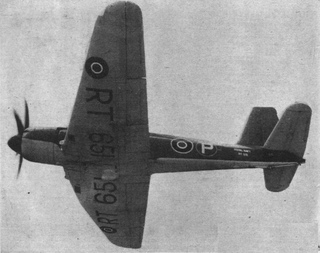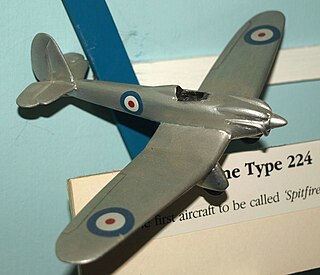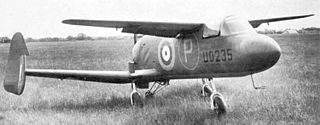
The Westland Whirlwind was a British twin-engined fighter developed by Westland Aircraft. A contemporary of the Supermarine Spitfire and Hawker Hurricane, it was the first single-seat, twin-engined, cannon-armed fighter of the Royal Air Force.

The Vickers Wellington is a British twin-engined, long-range medium bomber. It was designed during the mid-1930s at Brooklands in Weybridge, Surrey. Led by Vickers-Armstrongs' chief designer Rex Pierson, a key feature of the aircraft is its geodetic airframe fuselage structure, which was principally designed by Barnes Wallis. Development had been started in response to Air Ministry Specification B.9/32, issued in the middle of 1932, for a bomber for the Royal Air Force.

The Avro 679 Manchester was a British twin-engine heavy bomber developed and manufactured by the Avro aircraft company in the United Kingdom. While not being built in great numbers, it was the forerunner of the more famed and more successful four-engined Avro Lancaster, which was one of the most capable strategic bombers of the Second World War.

The Boulton Paul Defiant is a British interceptor aircraft that served with the Royal Air Force (RAF) during World War II. The Defiant was designed and built by Boulton Paul Aircraft as a "turret fighter" to meet the RAF requirement for day and night fighters that could concentrate their firepower on enemy bombers which were not expected to have fighter escorts due to the distance from Germany to the United Kingdom. The Defiant had all its armament in a dorsal turret offering the ability to fire in most directions. The same principle was used in the Royal Navy's Blackburn Roc which was also built by Boulton Paul.

The Supermarine Spiteful was a British fighter aircraft designed by Supermarine during the Second World War as a successor to the Spitfire. Powered by a Rolls-Royce Griffon engine, it had a radical new wing design to allow safe operations at higher speeds and incorporating inwards-retracting undercarriage. Other changes included a larger fin to improve the marginal stability of Griffon Spitfires. Development of the wing was formalised by Air Ministry specification F.1/43; as well as a new aircraft, there was an expectation the wing could be used as a replacement for the elliptical wing on Spitfire production.

The Blackburn B-20 was an experimental aircraft, first flying in 1940, that attempted to drastically increase the performance of flying boat designs. Blackburn Aircraft undertook an independent design study based on a patent filed by their chief designer, John Douglas Rennie for a retractable pontoon float that formed the planing hull.

The Blackburn Firebrand was a British single-engine strike fighter for the Fleet Air Arm of the Royal Navy designed during World War II by Blackburn Aircraft. Originally intended to serve as a pure fighter, its unimpressive performance and the priority allocation by the Ministry of Aircraft Production of Napier Sabre engines to the Hawker Typhoon caused it to be redesigned with an alternative engine as a strike fighter to take advantage of its load-carrying capability. Development was slow and the first production aircraft was not delivered until after the end of the war. Only a few hundred were built before it was withdrawn from front-line service in 1953.

The Boulton Paul P.120 was a research aircraft designed and produced by the British aircraft manufacturer Boulton Paul. It was the last aircraft design by the company to be flown.

The Short SB.4 Sherpa was an experimental aircraft designed and produced by the British aircraft manufacturer Short Brothers. Only a single example was ever produced.

The Blackburn B.48 Firecrest, given the SBAC designation YA.1, was a single-engine naval strike fighter built by Blackburn Aircraft for service with the British Fleet Air Arm during the Second World War. It was a development of the troubled Firebrand, designed to Air Ministry Specification S.28/43, for an improved aircraft more suited to carrier operations. Three prototypes were ordered with the company designation of B-48 and the informal name of "Firecrest", but only two of them actually flew. The development of the aircraft was prolonged by significant design changes and slow deliveries of components, but the determination by the Ministry of Supply in 1946 that the airframe did not meet the requirements for a strike fighter doomed the aircraft. Construction of two of the prototypes was continued to gain flight-test data and the third was allocated to strength testing. The two flying aircraft were sold back to Blackburn in 1950 for disposal and the other aircraft survived until 1952.

The Supermarine Type 224 was a British gull-wing monoplane fighter aircraft designed by R.J. Mitchell at Supermarine in response to Air Ministry Specification F.7/30, which sought to introduce a new fighter to succeed the Gloster Gauntlet. The Type 224 was powered by a Rolls-Royce Goshawk engine, which used an experimental evaporative cooling system.

In aeronautics, a tailless aircraft is a fixed-wing aircraft with no other horizontal aerodynamic surface besides its main wing. It may still have a fuselage, vertical tail fin, and/or vertical rudder.

The Westland Wizard was Westland Aircraft's first attempt to produce a monoplane fighter. The project was privately funded and the prototype design was done in the spare time of the company's engineers. This all happened during 1926, with high-speed performance as the primary goal.

The Westland F.7/30 was a British fighter prototype. A single prototype was built in 1934, but the type was not put in production because its performance fell far below the RAF's requirements. The Gloster Gladiator won the F.7/30 competition.

The Granger Archaeopteryx is a British single-engined, tailless parasol monoplane designed and built in the late 1920s by two brothers, R.F.T. and R.J.T. Granger. The sole example built is currently under restoration for flight.

The Miles M.35 Libellula was a tandem wing research aircraft built by Miles Aircraft as a precursor to a proposed naval carrier fighter. It was named after the Libellula, a genus of dragonflies.

The Gotha Go 147 was a German experimental two-seat tailless aircraft designed in 1936 by Gothaer Waggonfabrik and Dr. A. Kupper. Two examples were built and flown. Development was abandoned before the start of World War II.
The NRC tailless glider, also called the NRL tailless glider, was a two-seat tailless research glider designed by the National Research Council of Canada and built by the National Research Laboratories, at the instigation of G.T.R. Hill who had previously designed the British Westland-Hill Pterodactyl series of tailless aircraft.
The Blackburn F.3 was a British single-engined fighter aircraft produced in response to Air Ministry Specification F.7/30.
The Supermarine Type 324 and Type 325 were British two-engined fighter designs proposed as the replacement for the Supermarine Spitfire and Hawker Hurricane. Neither of them nor a revised design - the Type 327 - to carry cannon was accepted for development and production.



















